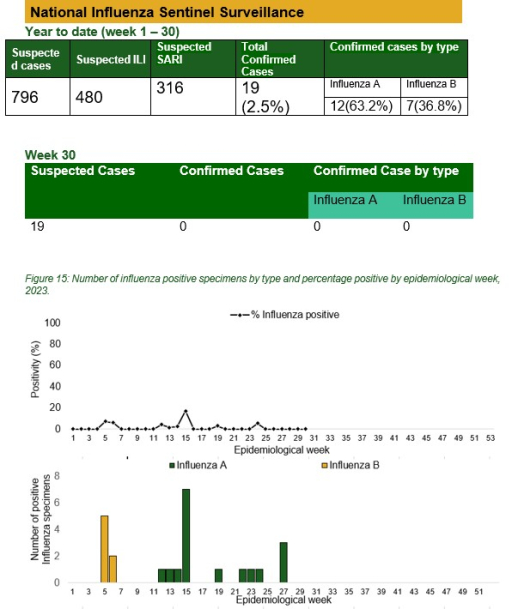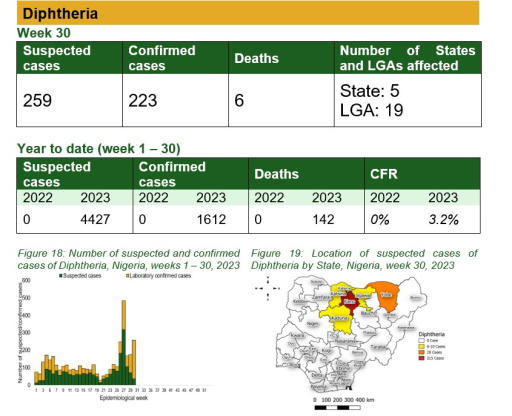In response to recommendations made to address gaps and challenges identified during Nigeria's 1st Joint External Evaluation (JEE) conducted in 2017, the National Action Plan for Health Security was developed. The implementation of this plan brought about significant investments by the Federal Government of Nigeria and its partners. This was a major driver for the documented 7% increase in the country’s readiness score observed during the country-led midterm JEE conducted in 2019. Some of the investments to enhance public health preparedness and response capacities include
- Passage of the Nigeria Centre for Disease Control and Prevention (NCDC) Bill.
- Digitisation of the national disease surveillance network.
- Development of a risk communication and community engagement framework across national, state and LGA levels
- Establishment of State Public Health Emergency Operation Centres (PHEOCs).
- Designation of three Points of Entry- Abuja, Kano and the Enugu International Airports with adequate structures and staff capacity for public health response.
- Increase in laboratory capacity at the national and sub-national levels.
Five years later, how far has Nigeria come in strengthening our national health security? Nigeria once again volunteered to conduct her 2nd JEE of IHR core capacities using the revised JEE 3.0 tool. This process kickstarted this week with a 5-day self-assessment exercise. This exercise brought together key stakeholders from all MDAs involved in health security to internally assess Nigeria’s capacities across the 19 technical areas of the IHR.
Summary of Incidents
1. Information for this disease was retrieved from the Technical Working Group and Situation Reports
2. Case Fatality Rate (CFR) for this disease is reported for confirmed cases only
3. CFR for this disease is reported for total cases i.e. suspected + confirmed
4. Information for sentinel influenza was retrieved from the laboratory

Lassa Fever
Key points
? There were 117 suspected cases of Lassa Fever reported from 28 LGAs in 10 states and FCT. There were 12 laboratory confirmed cases in four states and six deaths were recorded.
? One new Healthcare worker was affected in the reporting week.
Actions
To date:
? National Lassa fever multi-partner, multi-sectoral Technical Working Group (TWG) continues to coordinate the response activities at all levels
? De-escalation of the Lassa Fever EOC
? Deployed NRRT to 6 states – Bauchi, Benue, Ebonyi, Edo, Ondo & Taraba

Cerebrospinal Meningitis (CSM)
Key points
? There were 150 suspected cases of Cerebrospinal meningitis (CSM) reported from 5 LGAs in three states. There was one laboratory confirmed case and one death was recorded.
Actions
To date:
? National CSM TWG meets weekly to review reports from states and plan appropriately.
? Monitoring of epidemiological trend to guide plans for reactive vaccination campaigns,
? Implementation of CSM reactive vaccination campaign in high burden LGAs/Wards in Jigawa state led by NPHCDA.

Yellow Fever (YF)
Key points
? There were 21 suspected cases of Yellow Fever (YF) reported from 17 LGAs in 12 states. There was no laboratory confirmed case and no death was recorded.
Actions
To date:
? National YF multi-partner Technical Working Group (TWG) continues to coordinate activities across states.
? Daily monitoring and analysis of surveillance data across the country to guide response activities.
? Operationalisation of yellow fever regional reference laboratory for Borno State at University of Maiduguri Teaching Hospital Maiduguri, Borno State

Yellow Fever (YF)
Key points
? There were 21 suspected cases of Yellow Fever (YF) reported from 17 LGAs in 12 states. There was no laboratory confirmed case and no death was recorded.
Actions
To date:
? National YF multi-partner Technical Working Group (TWG) continues to coordinate activities across states.
? Daily monitoring and analysis of surveillance data across the country to guide response activities.
? Operationalisation of yellow fever regional reference laboratory for Borno State at University of Maiduguri Teaching Hospital Maiduguri, Borno State

Cholera
Key points
? There were four suspected cases of Cholera reported from four LGAs in four states. There was no laboratory confirmed case and no death was recorded.
Actions
To date
? National Cholera Multi-Sectoral Technical Working Group (TWG) is monitoring all states and supporting affected states.
? Ongoing surveillance in all states through the routine Integrated Disease Surveillance and Response (IDSR) and Event Based Surveillance (EBS).
? Continuous construction of sanitation and hygiene facilities with boreholes in cholera hotspots • Conducted WASH Sector review workshop.

Measles
Key points
? There were 61 suspected cases of Measles reported from 31 LGAs in 17 states. There was one laboratory confirmed case and no death was recorded.
Actions
To date
? National Measles TWG is closely monitoring measles surveillance data and providing feedback to relevant agencies and development partners.
? Ongoing weekly surveillance and laboratory data harmonisation.

Mpox
Key points
? There were 23 suspected cases of Mpox reported from 13 LGAs in nine states. There was no laboratory confirmed case and no death was recorded.
Actions
To date
? National Mpox Technical Working Group (TWG) is monitoring activities in all states.

Acute Flaccid Paralysis (AFP)
Key points
? There were 88 suspected cases of AFP reported from 49 LGAs in 21 states and FCT. There was no laboratory confirmed case and no death was recorded.

National Influenza Sentinel Surveillance

Coronavirus DIsease (COVID-19)
Key points
? There were two suspected cases of Covid 19 reported from one LGA in the FCT. There were two laboratory confirmed cases and no death was recorded.
Actions
To date:
• Multi-sectoral Public Health Emergency Operation Centres (PHEOC) activated at the National and affected States
• Engagement meetings with state teams on the ongoing response, Sitrep reporting and Ag-RDT data harmonization, challenges, and way forward.
• Mainstreaming of COVID-19 response activities into routine public health interventions such as surveillance, risk communication, testing etc.
? Enhance surveillance at points of entry.

Diphtheria
Key points
? There were 259 suspected cases of Diphtheria reported from 19 LGAs in five states. There were 223 confirmed cases, and 13 deaths were recorded.
Actions
To date
? National Diphtheria Technical Working Group (TWG) is monitoring activities in all states.

Event Based Surveillance (EBS)
Key points
For the reporting week 30:
• 79 Calls were successfully routed to agents and answered.
• 78 calls not routed to agents (Failed call)
• 152 total number of calls (successful and failed)
• Percentage of failed to total inbound calls 46.1%
• 0 signal picked
For week 1 - 30
• 11,918 calls successfully routed to agents and answered
• 2,369 calls not routed to agents (Failed call)
• 14,287 total inbound calls recorded
• Percentage of failed to total inbound calls: 16.6%
• 20 Signals picked and escalated to 36 states and FCT
Categories of Calls
• Report of health conditions
• Health Declaration-related queries
• Yellow Fever Vaccine enquiries
• Travel advisory enquiries
• TB related enquiries
• COVID19 Vaccine enquiries
• General enquiries
• Hoax call and others
















 Toll Free Number: 6232
Toll Free Number: 6232 Whatsapp: +234 708 711 0839
Whatsapp: +234 708 711 0839 SMS Number: +234 809 955 5577
SMS Number: +234 809 955 5577 